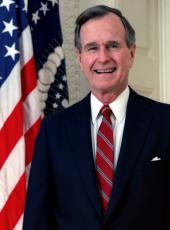By the President of the United States of America
A Proclamation
Of all the images and symbols that have come to represent the United States, from the towering figure of Uncle Sam to the beautiful yet fearsome bald eagle, the flag occupies a unique place in our hearts and in our history. It is our Nation's greatest emblem, the standard carried into battle by generations of brave and selfless Americans. As a tangible reminder of their great sacrifices, and as a symbol of the freedom with which we have been blessed, it is a banner we raise with a duly profound sense of pride and reverence.
The flag officially took shape on June 14, 1777, when the delegates to the Continental Congress resolved "that the flag of the thirteen United States be thirteen stripes, alternate red and white; that the Union be thirteen stars, white in a blue field, representing a new constellation." However, the Stars and Stripes had acquired meaning months earlier, when our Founding Fathers boldly affirmed the rights of individuals and declared America's independence from Great Britain. The "new constellation" of which the Continental Congress spoke was our young Nation, a nation where "freedom's holy light" would gleam forth, giving hope to all those living in the darkness of tyranny and serving as a guide to all those charting their own course toward liberty and self-government.
Today, in quiet glory, the Stars and Stripes continue to proclaim the shining promise of America. For millions of people around the world, the flag has bid welcome, marking a place of refuge from religious and political persecution. For millions of others, it has represented the liberty to which all men are heirs. When we look to the Red, White, and Blue, we cannot fail to take pride in the respect accorded to our flag around the world.
Our Nation's flag emerged from the triumphant struggle to represent the idea "that all men are greated equal, that they are endowed by their Creator with certain unalienable Rights, that among these are Life, Liberty and the pursuit of Happiness." One individual who recognized the importance of that struggle to all mankind was the Marquis de Lafayette. This courageous Frenchman understood that, because liberty is the God-given right of all men, the cause of freedom is universal. He eagerly joined in the American Revolution and, on July 31, 1777, wa appointed a Major General by the Continental Congress. Time and again throughout the Revolutionary War, Lafayette proved his bravery and his love of freedom. Shortly after the war's conclusion, he described its significance with these joyous words: "America is assured her independence; mankind's cause is won, and liberty is no longer homeless on earth."
Following his death in 1834, Lafayette was buried in the Picpus Cemetery in Paris, beneath American soil, as he had requested. On the Fourth of July just 6 weeks after his death, an American flag was raised above his grave. It is reported to have flown their continuously ever since, even during the German occupation of France during World War II.
Today the flag that flies over the grave of our dear friend, Lafayette, continues to serve as a reminder that the cause of liberty and democratic government is universal. Indeed, as Lafayette know so well, "freedom's holy light" can never be extinguished because God has given it a home in every human heart.
Wherever we look to Old Glory today -- whether in our schools, in our courts of law, or at isolated miliatary installations thousands of miles from these shores -- may all of us be united in our love for this great land of ours. On this joyous occasion, may we also renew our determination to uphold the ideals enshrined in our Constitution and Declaration of Independence, so that the flag might always be the symbol of a nation that is both great and good.
To commemorate the adoption of our flag, the Congress, by a joint resolution approved August 3, 1949 (63 Stat. 492), designated June 14 of each year as Flag Day and requested the President to issue an annual proclamation calling for its observance and for the display of the flag of the United States on all government buildings. The Congress also requested the President, by joint resolution approved June 9, 1966 (80 Stat. 194), to issue annually a proclamation designating the week in which June 14 occurs as National Flag Week and calling upon all citizens of the United States to display the flag during that week.
Now, Therefore, I, George Bush, President of the United States of America, do hereby proclaim June 14, 1990, as Flag Day, and the week beginning June 10, 1990, as National Flag Week. I direct the appropriate officials of the government to display the flag of the United States on all government buildings during that week. I urge all Americans to observe Flag Day, June 14, and Flag Week, by flying the Stars and Stripes from their homes and other suitable places.
I also urge the American people to celebrate those days from Flag Day through Independence Day, also set aside by the Congress (89 Stat. 211), as a time to honor America by having public gatherings and activities at which they can honor their country in an appropriate manner, including publicly reciting the Pledge of Allegiance to the Flag of the United States of America.
In Witness Whereof, I have hereunto set my hand this fourteenth day of June, in the year of our Lord nineteen hundred and ninety, and of the Independence of the United States of America the two hundred and fourteenth.

GEORGE BUSH
George Bush, Proclamation 6145—Flag Day and National Flag Week, 1990 Online by Gerhard Peters and John T. Woolley, The American Presidency Project https://www.presidency.ucsb.edu/node/268285

